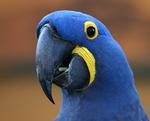
The Rules of Play
To reduce biting behavior in pet birds, don’t cause the behavior that you are trying to solve by playing roughly with your bird. A little ‘rough and tumble’ with your bird can soon get out of hand. Be sure not to tease your bird around its beak and don’t encourage it to engage in a ‘tug of war’ challenge with toys. Games like this teach your bird to compete with you and to push progressively harder to win. Aggression is then likely because it becomes too stimulated.
Instead, play games than involve no competition. ‘Fetch’, just as you would with a dog, is a good example. Throw a toy and encourage your feather duster to pick it up and give it to you. Praise the bird when it does and give it a food treat.
Reward Calm Behavior
The next step is to encourage your bird’s calm behavior and to avoid or ignore the aggression wherever you can. Feather Face will realize it is fun being calm and, by comparison, there is no benefit in being aggressive.
Use short training sessions, two to three times daily, to train your bird to be calm when being handled.
You will need a favorite food treat to ‘tick’ the bird’s calm behavior. The type of treats you can use varies from bird to bird, but millet sprays or sunflower seeds work well for most, although currants and similar soft fruits, as well as seeds, work well for birds like Lorikeets.

The progressive patting technique is the method to use. Firstly, hold a food treat in your fingers and offer the treat to your bird. While Feather Face is chewing the food, stroke him gently on the wings or forehead with your other hand. Five seconds of stroking is sufficient at this stage. Put the bird down and then walk away. Return in a minute or so for the next pat.
Repeat this routine five to ten times and then finish. If no aggression has occurred, you have scored a win and you are on your way to success. If aggression occurs at any time, use the Time Out principle described below.
Millet sprays are particularly good for those bird owners who feel they are likely to be bitten as the spray is long enough to distance your fingers from the bird’s barbaric beak. The spray can be cut shorter as the bird learns the fun of the game.
If you are successful, make the feeding and patting sessions progressively longer but don’t rush too fast. You will find that it is far better to go slowly and not cause aggression than to try to backtrack if aggression has occurred.

If your bird does try to bite, then the Time Out process is the easiest way to control it. The aggression needs to be brought to a rapid stop but as gently as possible. I find the easiest method is to use a plastic laundry basket or a budgerigar cage without its bottom. The process is simple. If the bird bites, quickly place the laundry basket or cage over the fierce feathered fiend to gently trap it there. Then walk away.
This is a calming strategy. The goal is to prevent any worsening of the aggression and to give the bird time to regain its composure. Most importantly, it gives you an opportunity to be able to reward your bird when its calm behavior returns.
It should only take two to five minutes for Feather Face to become calm. Certainly don’t leave your bird in its time-out cage for more than five minutes as this will only upset the bird and you will lose the progress you have made.
Test your bird’s mood by offering a food reward through the bars of the cage. If Feather Face is friendly, its reward is to be released from the cage. Pick it up, give it a pat and tickle, offer another food reward and then leave it alone for a while.
Handling aggression in birds is quite simple if you use the correct techniques. Remember not to cause the aggression through rough handling, to terminate any aggression quickly using Time Out and to reward calm behavior as often as you can.
